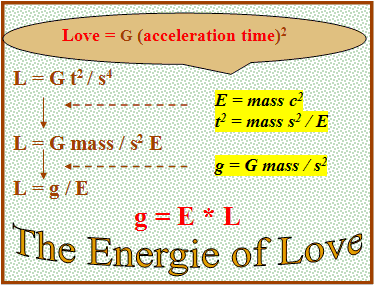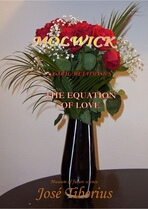3.b) Acceleration due to gravity
The concept of gravity has two aspects. On the one hand, a body exerts acceleration *g* onto another within its gravitational field. It is independent of the mass of the second body. In addition, it will vary with the distance squared.
acceleration = space / time ² = m / s ²
In other words, gravity is a force of attraction per unit of mass onto another object.
Force / mass = acceleration
N / kg = m / s²
The second refers to gravity as a force of attraction between two bodies, typically applied to force between planets or other stellar bodies. In this case, it is the force applied to the whole body, and we have:
Force = mass * force / mass
force / mass = acceleration
N = kg N kg = kg m / s²
Logically, the attraction to each other results from the existence of the two masses and their corresponding gravity fields. Still, there are two forces, one exerted by the field of an object on the other object and the second exerted by the second field on the first mass.
The acceleration of gravity or force per the unit of mass will be:
g = G mass / space ²
Where G = 6.67 * 10-11 (m³/kg s²) or (N m² / kg²), by not depending on its spatial situation nor on the environment in which the masses find themselves, it is said that G is the Universal Gravitational Constant. It is also worth pointing out that in the different values of the gravity acceleration on the Earth’s surface, we include the effect of the centrifugal force due to the Earth’s rotation, even though we have not stated it for reasons of simplicity.
Gravity as a total force of attraction over another mass will be the intensity of the gravitational field at one point:
F = g mass2 = G mass 1 mass2 / space²
Newton’s apple is fascinating because it does not make sense as an explanation for the inspiration for the law of gravity. It reminds of the biblical connotation of the word and that the ideas formed by thinking of those natural forces of attraction such as love, which is why he mentioned the apple.
It is interesting to note that Newton worked in the London Mint. He also occupied himself with theology and biblical questions, leaving some works about this subject, his “Isaaci Newtoni Opera quae exstant omnia” (1779), published by Horsley. Perhaps that is where the Celestial mechanics’ comes?
However, as we have seen in the previous section, love is more of a relationship than a force.
3.b.1. The formula for the subjective gravity acceleration
Let us look at another way of defining and quantifying gravity acceleration, energy, and love.
In the Equation of Love, if we substitute time squared with its value in Albert Einstein’s equation for the relationship between energy and mass E=mc² –originally from Olinto de Pretto–, we get an equivalence where love is equal to gravity divided by energy.
for gravity acceleration

Note that by breaking down *c* into *s/t* and solving for t² from Olinto de Pretto’s equation, time does not have to be equal to one, given that it vanishes together with its corresponding space with the substitution.
Let us look at some specific values for the acceleration due to gravity, energy, and love in these formulas that are so metaphysical and magical (the most interesting is the last one):
-
The value the Love Equation (L = Gt²/ e4)takes on, when the acceleration of time is 1 s/c², will be equal to the relation between the acceleration of gravity, exerted by a central mass of 1 kg to a distance equal to *c*. Moreover, its energy will be equivalent to c² Jules. Also, it will be identical to the unit amorcito, which was:
L = 1 amorcito = G/c²c² = 8.26069 * 10-45 (1/kg m) = G mass /s² E
This unit also means the acceleration of gravity-induced by the energy of one Julio with a relation equal to 1 amorcito (g= L * E). Once again, we see that love represents the gravity of energy, or the latter is the gravity of love.
Another significant quantity would be love as a relation between gravity acceleration and energy that would result of an object with a mass of 1 kg to a distance of 1 meter, and assuming that 1 Julio was its equivalent energy, which would be equal to:
L = G mass / s ² E = G [(N/kg) / (N m)]
In other words, L would be equal to G if the speed of light *c* were *1 m/s*. We are doing mental exercises so that the neurons intuitively understand that the fundamental constants express the relations of unitary equivalence between the different physics magnitudes.
Since we are in a metaphysics book, we can play a little with physics. We are going to think the Equation of Love does not represent the acceleration of time. As we have seen previously, it is not equal to the inverse of the typical acceleration of space. Still, it means the speed of time in a particular point of squared space, in a location with a specific gravitational intensity.
In other words, the Equation of Love is the same, but a different interpretation allows us to separate the distance c² from a distance *r* in the calculation of gravity acceleration. Moreover, for the Earth’s surface, it will be:
L = G/c4 * c²/r² * m/m 1,82502E-41 8,26069E-45 2,20929E+03 1 Furthermore, Love or the gravity/energy relation would vary with the square of the relationship between the distance *c* and the distance *r*; since the mass of Newton’s formula is compensated by the energy; for example, the equivalent mass *m* of the photon emitted by the hydrogen atom on the Earth’s surface.
-
A degree of greater freedom in the Equation of Love would be to see what happens with other relations between gravity and energy, even if they were not equivalent. Since nothing impedes its analysis, so that by calculating the formula of the gravity force on the Earth’s surface with its mass *M* about the energy indicated from the photon of the hydrogen atom, we have:
L = G/c4 * c²/r² * M/m = 1 Mw = c / G [(N/kg) / (N m) ]
An intriguing oddity since it is a rounded number; on the other hand, the value of the formula A adjusted to the Earth’s surface coincides with the value of the unit we had defined as Molwick duly advised by Sir Magicwick.
c/G = L = G/c4 * c²/r² * M/m 4,49493E+18 8,26069E-45 2,20929E+03 2,46294E+59 Lastly, by correspondingly rearranging the previous equality, we are left with unquestionable physics equality and somehow surprising:
g = E * L 9,79838E+00 2,17987E-18 4,49493E+18 Solving for g in the resulting equality, we have that it is equal to energy multiplied by love. We came to the same qualitative result by analyzing the meaning of love regarding physics by only interpreting its units.
If the previous equality had a general nature, we could calculate the gravity acceleration at any point, knowing the energy of the photon emitted from the hydrogen atom at it and the constants *c/G*. Assuming that *c* and *G* were constants, a matter that is darker every day.
The gravity formula refers to the relationship with gravity at the moment and place of a photon generation, not the number of photons.
Nonetheless, back to metaphysics, we could say that gravity is the energy of love!
When I saw a photo of you, for a moment my heart stopped,
when I first met you, I almost fainted,
when you left me, my ... wanted to commit suicide,
when you came back to me, my brain could not believe it,
Now I am afraid of waking up
and keep dreaming about you.
